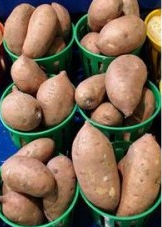 Potatoes are enjoyed in various authentic international cuisines, specifically in Latin America countries. For centuries, the potato has been the main source of income for farmers and their families. In Uruguay, potatoes help to improve the countries economic status by being a major exporting crop in their agriculture market.
Potatoes are enjoyed in various authentic international cuisines, specifically in Latin America countries. For centuries, the potato has been the main source of income for farmers and their families. In Uruguay, potatoes help to improve the countries economic status by being a major exporting crop in their agriculture market.
In 2001, Uruguayan’s exporting began declining because of a plant disease called Bacterial wilt (Ralstonia solanacearum). It was found in 39 percent of samples from Uruguayan potato farms and forced the country to import potato seed. This fungus is extremely difficult to get rid because it multiples quickly in high moisture environments such as South America. It has also been found to infect other crops such as sweet potato and cassava, which are common in other developing countries.
In order to completely eliminate the fungus, farmers have to suffer the loss of their main source of income for their families and make the difficult decision to remove their entire yield. It is necessary for farmers to quickly choose their plan of action because the permanent wilting of the crop causes crops to die in a short period of time. Otherwise, the fungus has the potential to spread among farming supplies, soils, and water irrigation systems.
The United Nations Food and Agriculture Organization (FAO) and International Treaty on Plant Genetic Resources for Food and Agriculture (ITPGRFA) recognize that sufficient funding is an impediment for many poverty-stricken countries. In addition, implementing sustainable agricultural development is very challenging when their economic status is at risk. In 2008, the ITPGRFA Treaty Benefit-sharing Fund Project granted funding for 11 projects, including the Uruguayan potato research which was the first project to be approved.
Scientists at the National Institute for Agricultural Research (INIA) of Uruguay developed the potato species Solanum commersonii (S. commersonii), using a 75 year old genetic technique called introgressive hybridization. This potato species evolved from transferring the traits of a “native wild-relative” potato species, Solanum phureja (S. phureja) and a commercial potato species. The outcome was a new Uruguayan potato that is naturally resistant to Bacterial Wilt, drought, and cold temperatures.
The expansion of native crop species through diversification is one way to sustain agriculture development. The ITPGRFA Uruguay potato project indicates the significance of supporting traditional (indigenous) knowledge in research and development. Now farmers in the Uruguayan potato sector can continue to gain income for their families and enjoy nutritious, disease resistant potatoes in their Latin cuisines.
To read more on innovation through scientific techniques, see: Potato, Potahto, The Locust Bean: An Answer to Africa’s Greatest Needs in One Tree, Drought, Pest, Disease and Taste: A Sweet Potato for Every Occasion.
Kaia E. Clarke is a research intern for the Nourishing the Planet project.

Danielle Nierenberg, an expert on livestock and sustainability, currently serves as Project Director of State of World 2011 for the Worldwatch Institute, a Washington, DC-based environmental think tank. Her knowledge of factory farming and its global spread and sustainable agriculture has been cited widely in the New York Times Magazine, the International Herald Tribune, the Washington Post, and
other publications.
Danielle worked for two years as a Peace Corps volunteer in the Dominican Republic. She is currently traveling across Africa looking at innovations that are working to alleviate hunger and poverty and blogging everyday at Worldwatch Institute’s Nourishing the Planet. She has a regular column with the Mail & Guardian, the Kansas City Star, and the Huffington Post and her writing was been featured in newspapers across Africa including the Cape Town Argus, the Zambia Daily Mail, Coast Week (Kenya), and other African publications. She holds an M.S. in agriculture, food, and environment from Tufts University and a B.A. in environmental policy from Monmouth College.








